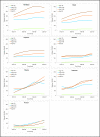Invasive breast cancer incidence trends by detailed race/ethnicity and age
- PMID: 21351091
- PMCID: PMC3196818
- DOI: 10.1002/ijc.26004
Invasive breast cancer incidence trends by detailed race/ethnicity and age
Abstract
Racial/ethnic disparities in breast cancer incidence may contain important evidence for understanding and control of the disease. Monitoring the incidence trends of breast cancer by race/ethnicity allows identification of high risk groups and development of targeted prevention programs. Using population-based cancer registry data from the Los Angeles Cancer Surveillance Program, we examined the invasive female breast cancer incidence trends among the diverse racial/ethnic populations in Los Angeles County, California, from 1972 to 2007. Age-adjusted incidence rates (AAIRs) and age-specific incidence rates (ASIRs) were calculated and examined respectively for non-Hispanic (NH) white, black, Hispanic, Chinese, Filipina, Japanese and Korean women by calendar year and time period. Rising trends of AAIRs were found in all racial/ethnic groups during the 1980s and 1990s. The breast cancer risk increased more substantially in Japanese and Filipinas than in Chinese and Koreans. During 2000-2007, the trends of AAIRs declined significantly among NH white women and slightly in blacks, remained unchanged for Hispanics and continued to rise significantly among all Asian subgroups. The patterns of ASIRs by race/ethnicity changed dramatically over time. By 2000-2007, younger Hispanic women had the lowest breast cancer risk, replacing the Chinese and Koreans who formerly had the lowest risk. Rapidly increasing breast cancer incidence trends among Asian-Americans underline the importance of behavioral and lifestyle changes as a result of acculturation on the development of the disease. The unique trends of breast cancer incidence by race/ethnicity suggest the need for targeted breast cancer control programs for different racial/ethnic populations.
Copyright © 2011 UICC.
Figures




Similar articles
-
Rapidly rising breast cancer incidence rates among Asian-American women.Int J Cancer. 2002 Jun 10;99(5):747-50. doi: 10.1002/ijc.10415. Int J Cancer. 2002. PMID: 12115511
-
Recent breast cancer trends among Asian/Pacific Islander, Hispanic, and African-American women in the US: changes by tumor subtype.Breast Cancer Res. 2007;9(6):R90. doi: 10.1186/bcr1839. Breast Cancer Res. 2007. PMID: 18162138 Free PMC article.
-
Striking Racial/Ethnic Disparities in Liver Cancer Incidence Rates and Temporal Trends in California, 1988-2012.J Natl Cancer Inst. 2018 Nov 1;110(11):1259-1269. doi: 10.1093/jnci/djy051. J Natl Cancer Inst. 2018. PMID: 29617913 Free PMC article.
-
Incidence Trends of Breast Cancer Molecular Subtypes by Age and Race/Ethnicity in the US From 2010 to 2016.JAMA Netw Open. 2020 Aug 3;3(8):e2013226. doi: 10.1001/jamanetworkopen.2020.13226. JAMA Netw Open. 2020. PMID: 32804214 Free PMC article.
-
Breast cancer statistics, 2013.CA Cancer J Clin. 2014 Jan-Feb;64(1):52-62. doi: 10.3322/caac.21203. Epub 2013 Oct 1. CA Cancer J Clin. 2014. PMID: 24114568 Review.
Cited by
-
Integrative molecular profiling identifies a novel cluster of estrogen receptor-positive breast cancer in very young women.Cancer Sci. 2019 May;110(5):1760-1770. doi: 10.1111/cas.13982. Epub 2019 Apr 2. Cancer Sci. 2019. PMID: 30811755 Free PMC article.
-
Characteristics of The Cancer Genome Atlas cases relative to U.S. general population cancer cases.Br J Cancer. 2018 Oct;119(7):885-892. doi: 10.1038/s41416-018-0140-8. Epub 2018 Aug 21. Br J Cancer. 2018. PMID: 30131556 Free PMC article.
-
Natrelle Silicone Breast Implant Follow-Up Study: Demographics, Lifestyle, and Surgical Characteristics of More Than 50,000 Augmentation Subjects.Plast Reconstr Surg. 2016 Jan;137(1):70-81. doi: 10.1097/PRS.0000000000001851. Plast Reconstr Surg. 2016. PMID: 26710009 Free PMC article. Clinical Trial.
-
Synthesis and biological evaluation of aminonaphthols incorporated indole derivatives.Int J Med Chem. 2014;2014:673206. doi: 10.1155/2014/673206. Epub 2014 Sep 10. Int J Med Chem. 2014. PMID: 25383220 Free PMC article.
-
Cancer incidence trends among native Hawaiians and other Pacific Islanders in the United States, 1990-2008.J Natl Cancer Inst. 2013 Aug 7;105(15):1086-95. doi: 10.1093/jnci/djt156. Epub 2013 Jul 22. J Natl Cancer Inst. 2013. PMID: 23878354 Free PMC article.
References
-
- Writing Group for the Women's Health Initiative Investigators Risks and benefits of estrogen plus progestin in healthy postmenopausal women: principal results from the Women's Health Initiative randomized controlled trial. JAMA. 2002;288:321–33. - PubMed
-
- Ravdin PM, Cronin KA, Howlader N, Berg CD, Chlebowski RT, Feuer EJ, Edwards BK, Berry DA. The decrease in breast cancer incidence in 2003 in the United States. N Engl J Med. 2007;356:1670–1674. - PubMed
-
- Kerlikowske K, Miglioretti DL, Buist DSM, Walker R, Carney PA. Declines in invasive breast cancer and use of postmenopausal hormone therapy in a screening mammography population. J Natl Cancer Inst. 2007;99:1335–1339. - PubMed
-
- Robbins AS, Clarke CA. Regional changes in hormone therapy use and breast cancer incidence in California from 2001 to 2004. J Clin Oncol. 2007;25:3437–3439. - PubMed
-
- Clarke CA, Glaser SL. Declines in breast cancer after the WHI: apparent impact of hormone therapy. Cancer Causes Control. 2007;18(8):847–852. - PubMed
Publication types
MeSH terms
Grants and funding
LinkOut - more resources
Full Text Sources
Medical

